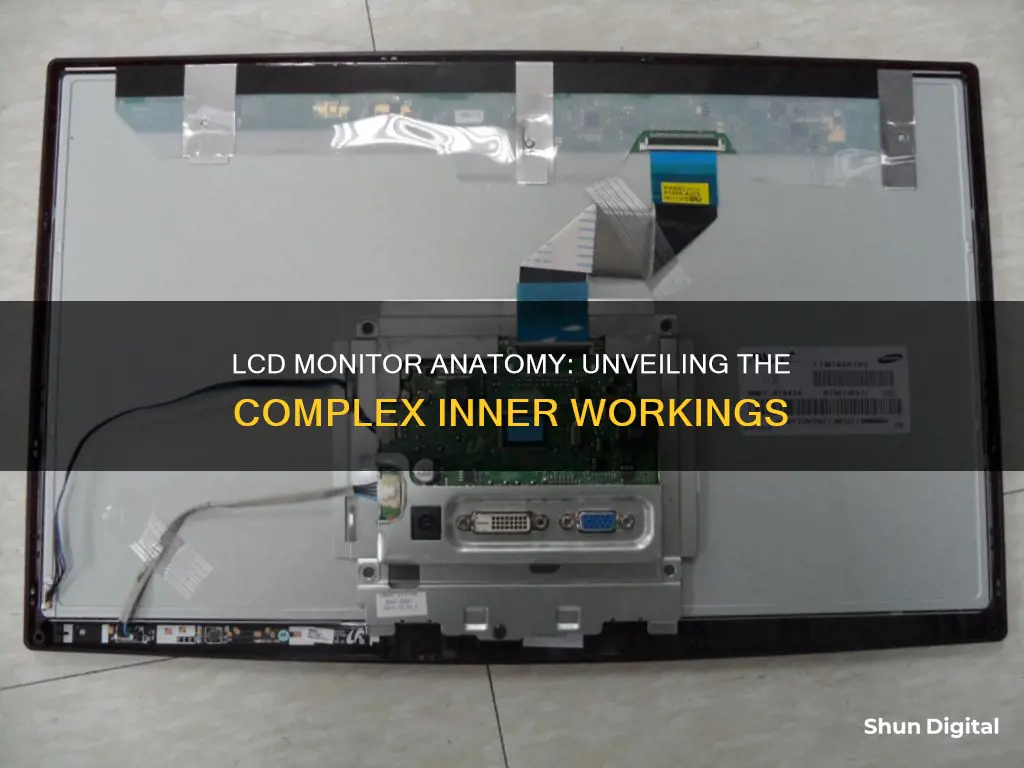
LCD monitors, or Liquid Crystal Displays, are flat-panel displays that use liquid crystals to control light passage and create images. They are made up of two pieces of polarized glass that contain a liquid crystal material between them. A backlight—usually a cold cathode fluorescent lamp (CCFL) or light-emitting diodes (LEDs)—creates light that passes through the first substrate of polarized glass. Electrical currents then cause the liquid crystal molecules to align and allow varying levels of light to pass through to the second substrate, creating colours and images.
LCD monitors are typically thinner, more energy-efficient, and cheaper than older monitors with cathode ray tube (CRT) technology. They also offer good colour reproduction and brightness. However, LCD monitors may struggle to produce true blacks, and can be susceptible to problems such as a completely white screen, vertical lines, or a lack of picture.
LCD monitors can be made with either a passive matrix or an active matrix display grid. Active matrix LCDs, also known as thin-film transistor (TFT) displays, have a transistor located at each pixel intersection, requiring less current to control the luminance of a pixel. Passive matrix LCDs, on the other hand, have a grid of conductors with pixels located at each intersection. While active matrix LCDs offer improved screen refresh times, passive matrix LCDs are less expensive to produce.
What You'll Learn

Polarized glass filters
LCD pixels consist of several layers, including a pair of linear polarizers and a layer of nematic liquid crystal. The liquid crystals are responsible for rotating the polarization axis of light as it passes through. When no voltage is applied, the liquid crystals twist, allowing light to pass through and creating a bright pixel. However, when voltage is applied, the liquid crystals align with the applied field, blocking the light and resulting in a dark pixel. By adjusting the voltage, any amount of light can pass through, creating different levels of gray.
LCD monitors can be converted into "stealth" displays by removing the outer polarizing filter. This results in a screen that appears bright and featureless to the naked eye. However, when viewed through a vertical polarizing filter, such as a pair of polarizing sunglasses, the original image becomes visible. This technique can be used to add an extra layer of security and privacy to your monitor, ensuring that only individuals wearing the polarized glasses can view the displayed information.
Factors to Consider When Choosing the Right Monitor Size
You may want to see also

Liquid crystal molecules
Liquid crystals are substances with properties of both liquids and solids. They are used in liquid crystal displays (LCDs) to control the passage of light. When exposed to electricity, the molecular structure of liquid crystals changes, allowing them to align to either allow or block light, thus creating images on a screen.
LCDs typically consist of a layer of molecules aligned between two transparent electrodes, often made of indium tin oxide (ITO). Each pixel on an LCD screen consists of three subpixels (red, green, and blue). These subpixels can change colour combinations, allowing the display to produce millions of different colours.
Liquid crystals can be categorised into nematic and smectic liquid crystals. Nematic liquid crystals align with their axes in parallel, while smectic liquid crystals arrange themselves in layered sheets. The molecules of smectic liquid crystals may take on different alignments relative to the plane of the sheets, resulting in different smectic phases.
The optical properties of liquid crystals depend on the direction of light travel. An electric field can change the orientation of the molecules in a layer of liquid crystal, affecting its optical properties. This process, known as an electro-optical effect, is the basis for LCDs.
The first LCDs used a light-scattering effect known as the dynamic scattering mode. However, issues with readability and the limited lifetime of liquid crystal materials led to the development of twisted nematic (TN) displays, which are now commonly found in computer monitors and flat-panel televisions.
Monitor Sizes: Bezels Included or Not?
You may want to see also

Transparent conductive materials
The most common type of transparent conductive electrode (TCE) is a doped metal oxide-coated glass, such as tin-doped indium oxide (ITO), fluorine-doped tin oxide (FTO), and aluminum zinc oxide (AZO). However, metal oxide materials have several limitations, including the scarcity of indium and the resulting high costs. Additionally, ITO, FTO, and AZO are brittle and therefore unsuitable for flexible electronic devices.
As a result, alternatives to ITO-based TCFs are being explored, such as single-walled carbon nanotubes (SWCNTs) and metal nanowires. SWCNTs are more conductive than copper, can be made into an ink that can be applied at room temperature and pressure, and are more durable and flexible than ITO or silver. They can also be made from renewable resources, unlike ITO.
Another emerging material for fabricating TCEs is graphene. Graphene has high electrical and thermal conductivity, high mechanical strength, and chemical stability. It is also transparent across the entire visible region and into the far infrared. A four-layer graphene film can result in a sheet resistance of 15 Ω/sq. and a transmittance of ~90%, making it suitable for most transparent conductor applications.
Other options for transparent conductive materials in LCDs include PEDOT and high and low ohmic transparent conductive materials.
Monitoring Internet Bandwidth Usage: A Guide for LAN Admins
You may want to see also

Backlight
LCD stands for Liquid Crystal Display. LCDs are flat-panel displays that use liquid crystals to control the passage of light and create images. They are commonly found in smartphones, televisions, computer monitors, and instrument panels.
LCDs require a backlight to produce a visible image as they do not produce light by themselves. The backlight is usually the first layer from the back of the display. The backlight is a form of illumination that comes from the back or side of the display panel.
There are several types of backlights, including:
- Light-emitting diodes (LEDs)
- Electroluminescent panels (ELPs)
- Cold cathode fluorescent lamps (CCFLs)
- Hot cathode fluorescent lamps (HCFLs)
- External electrode fluorescent lamps (EEFLs)
- Incandescent lightbulbs
LEDs are the most common type of backlight used in LCDs. LED-backlit LCDs use the same TFT LCD (thin-film-transistor liquid-crystal display) technologies as CCFL-backlit LCDs but offer a range of advantages, including:
- A wider color gamut and dimming range
- A greater contrast ratio
- A slim design (some screens are less than 0.5 inches thin)
- Lower power consumption and longer lifespan
The use of LED backlights in LCDs has been growing due to their superior performance and energy efficiency. However, LCDs with LED backlights may struggle to produce true blacks as black pixels still allow some light from the backlight to pass through.
Overall, the backlight is an essential component of LCDs, providing the illumination needed to create a visible image on the display.
Removing Moisture from LCD Monitors: DIY Guide
You may want to see also

Active and passive matrix displays
Passive matrix displays are a type of display technology that uses a grid of vertical and horizontal conductive lines (known as electrodes) to control pixels. The pixels are located at the intersections of these rows and columns, and when a voltage is applied, the pixel at that intersection is activated, changing its optical properties and causing it to light up. This type of display is simple and inexpensive to produce, but it has slower response times and lower contrast than active matrix displays.
Passive matrix displays rely on a grid of electrodes to control pixels at their intersections instead of individual transistors. They have a simpler structure compared to active matrix displays and require fewer components, making them more affordable. However, they have slower response times due to the refresh process, which can cause ghosting and blurring, especially in fast-moving images or videos. The way passive matrix controls pixels also restricts viewing angles, and the picture quality might significantly degrade if viewed from the side.
An active matrix display, on the other hand, uses thin-film transistors that are arranged in a matrix on a glass surface. These transistors act as switches, allowing for precise control of each pixel's state. Each pixel is paired with a dedicated transistor, and when a voltage is applied, the transistor charges the capacitor connected to the pixel, which maintains its state until the next refresh cycle. This configuration enables faster response times and better image quality.
The most common type of active matrix display is the Thin Film Transistor (TFT) technology. In these displays, signal electrodes carry the video signal and supply the voltage needed to control the transistors in each column, while control electrodes are responsible for activating the transistors. The individual transistors ensure that each pixel maintains its state, resulting in sharper and more stable images with better contrast. Active matrix displays also provide superior viewing angles.
Active matrix displays are more complex to manufacture and, therefore, more expensive. They also generally consume more power. However, their superior performance makes them ideal for high-end industrial screens, smartphones, tablets, monitors, and TVs.
Standard Monitor Size: Understanding 1366x768 Resolutions
You may want to see also
Frequently asked questions
LCD stands for Liquid Crystal Display. LCD monitors use liquid crystals to control the passage of light and create images. They are typically thinner and more energy-efficient than older CRT monitors.
An LCD monitor consists of two pieces of polarized glass with a layer of liquid crystal material between them. A backlight creates light that passes through the first piece of glass. Electrical currents cause the liquid crystal molecules to align, allowing varying levels of light to pass through to the second piece of glass and create colours and images.
There are two main types of LCD monitors: passive matrix and active matrix (also known as thin-film transistor or TFT displays). Passive matrix LCDs are less common today due to their slow response times and imprecise voltage control. Active matrix LCDs have a transistor at each pixel intersection, allowing for more frequent current switching and improved screen refresh times.
LCD monitors offer good colour reproduction and brightness, and are typically thinner and more energy-efficient than CRT monitors. They are also generally more affordable than LED monitors. However, LCD monitors may struggle to produce true blacks, and can be more prone to issues such as backlight bleed and clouding.







